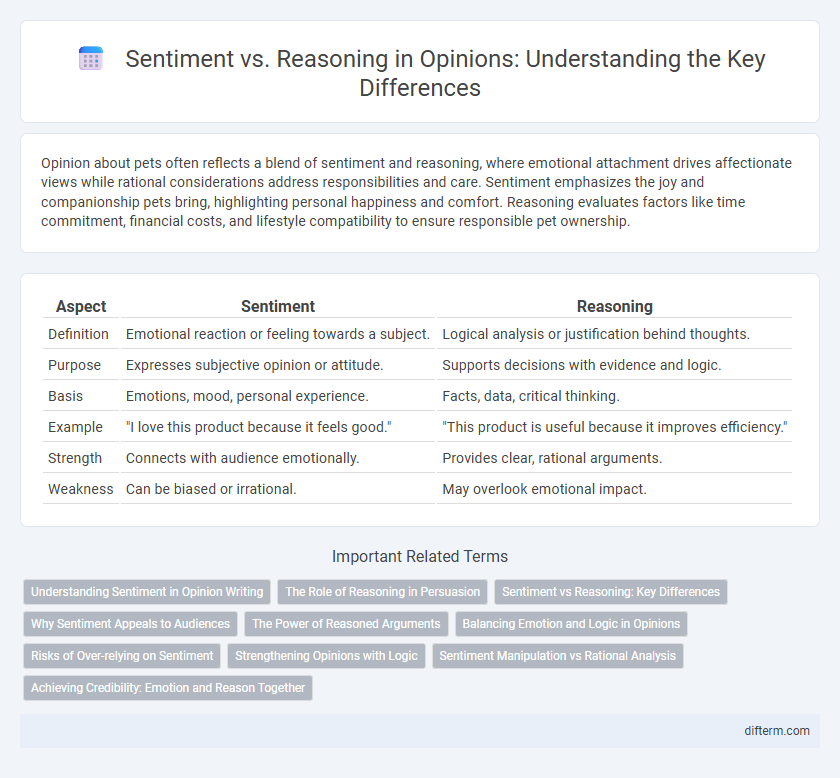Opinion about pets often reflects a blend of sentiment and reasoning, where emotional attachment drives affectionate views while rational considerations address responsibilities and care. Sentiment emphasizes the joy and companionship pets bring, highlighting personal happiness and comfort. Reasoning evaluates factors like time commitment, financial costs, and lifestyle compatibility to ensure responsible pet ownership.
Table of Comparison
| Aspect | Sentiment | Reasoning |
|---|---|---|
| Definition | Emotional reaction or feeling towards a subject. | Logical analysis or justification behind thoughts. |
| Purpose | Expresses subjective opinion or attitude. | Supports decisions with evidence and logic. |
| Basis | Emotions, mood, personal experience. | Facts, data, critical thinking. |
| Example | "I love this product because it feels good." | "This product is useful because it improves efficiency." |
| Strength | Connects with audience emotionally. | Provides clear, rational arguments. |
| Weakness | Can be biased or irrational. | May overlook emotional impact. |
Understanding Sentiment in Opinion Writing
Understanding sentiment in opinion writing enhances the clarity of the message by revealing the writer's emotional stance and intent. Analyzing sentiment enables readers to grasp nuanced opinions and underlying biases that pure reasoning may overlook. Sentiment detection tools use linguistic cues and contextual patterns to identify positive, negative, or neutral tones, enriching interpretation beyond logical arguments.
The Role of Reasoning in Persuasion
Reasoning plays a critical role in persuasion by providing logical foundations that support a message's credibility and appeal. While sentiment appeals to emotions, reasoning ensures arguments are coherent, evidence-based, and withstand critical scrutiny, leading to more enduring influence. Effective persuasion integrates both emotional and rational elements but relies heavily on sound reasoning to foster informed decision-making.
Sentiment vs Reasoning: Key Differences
Sentiment relies on emotional responses and subjective feelings, while reasoning is based on logical analysis and objective evaluation. Sentiment often drives immediate judgments influenced by personal biases, whereas reasoning seeks to support conclusions through evidence and critical thinking. Understanding the distinction between sentiment and reasoning is essential for effective decision-making and balanced opinions.
Why Sentiment Appeals to Audiences
Sentiment appeals to audiences because it directly engages emotions, creating a personal and relatable connection that reasoning alone often lacks. Emotional responses are processed faster in the brain, making sentiment more immediate and memorable. This instant resonance drives audience engagement, fostering empathy and loyalty.
The Power of Reasoned Arguments
Reasoned arguments harness logical structure and evidence, enhancing persuasive power and fostering critical thinking. Unlike sentiment-driven appeals, which rely on emotional response, reasoned discourse promotes informed decision-making and sustained consensus. Mastery of reasoned arguments is essential for effective communication in academic, professional, and social contexts.
Balancing Emotion and Logic in Opinions
Balancing emotion and logic in opinions enhances credibility and persuasiveness by integrating sentiment with clear reasoning. Expressing emotions helps connect with audiences on a personal level while backing opinions with evidence and analysis ensures rational understanding. This synergy between feeling and thought fosters well-rounded perspectives that resonate and withstand scrutiny.
Risks of Over-relying on Sentiment
Over-relying on sentiment in decision-making risks clouding judgment with emotional biases, leading to impulsive choices rather than rational analysis. Sentiment-driven actions can overlook critical data and long-term consequences, increasing vulnerability to errors and financial losses. Effective reasoning ensures balanced assessments, reducing the hazards associated with fluctuating emotions and subjective perceptions.
Strengthening Opinions with Logic
Strengthening opinions with logic enhances credibility by grounding feelings in evidence and rational thought. Using clear premises and well-structured arguments improves persuasive impact and fosters thoughtful dialogue. Logical reasoning bridges emotional reactions with objective analysis, creating balanced and compelling viewpoints.
Sentiment Manipulation vs Rational Analysis
Sentiment manipulation exploits emotional biases to influence decisions, often bypassing critical thinking and rational analysis. Rational analysis relies on objective evaluation of facts and logical reasoning, reducing susceptibility to emotional distortions. Understanding the difference is crucial for resisting manipulation and fostering informed, balanced judgments.
Achieving Credibility: Emotion and Reason Together
Achieving credibility in opinion pieces requires a balance between sentiment and reasoning, where emotional appeal engages readers while logical arguments build trust. Integrating personal experiences with factual evidence enhances persuasive impact, making the viewpoint both relatable and convincing. Research shows that combining pathos and logos increases audience retention and fosters a deeper connection to the message.
sentiment vs reasoning Infographic

 difterm.com
difterm.com